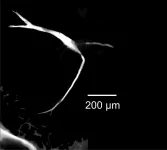Brain damage caused by plasticisers
Bayreuth biologists investigate effects of bisphenols on nerve cells
2021-04-12
(Press-News.org) The plasticisers contained in many everyday objects can impair important brain functions in humans. Biologists from the University of Bayreuth warn of this danger in an article in Communications Biology. Their study shows that even small amounts of the plasticisers bisphenol A and bisphenol S disrupt the transmission of signals between nerve cells in the brains of fish. The researchers consider it very likely that similar interference can also occur in the brains of adult humans. They therefore call for the rapid development of alternative plasticisers that do not pose a risk to the central nervous system.
Bisphenols are plasticisers that are found in a large number of plastic products worldwide - for example, in food packaging, plastic tableware, drinking bottles, toys, tooth fillings, and babies' dummies. In recent years, numerous health risks have already been associated with them, especially with bisphenol A (BPA). The Bayreuth research team led by Dr. Peter Machnik at the Animal Physiology research group (led by Prof. Dr. Stefan Schuster) has now for the first time investigated the effects of plasticisers on signal transmission between nerve cells in the adult brain. The study covers not only BPA, but also bisphenol S (BPS), which is often considered less harmful to health. Their findings: Both plasticisers impair communication between the nerve cells of the brain.
Permanent damage to the nervous system
The harmful effects on the brain mainly affect the delicate balance between different neuronal functions. While some brain cells transmit signals that trigger a state of excitation in downstream cells, other brain cells have the function of inhibiting downstream cells. However, the coordination of both excitation and inhibition is essential for an intact central nervous system. "It is well known that numerous disorders in the nervous system of vertebrates are triggered by the fact that excitatory signals and inhibitory signals are not or only inadequately coordinated. So, it is all the more alarming that the plasticisers BPA and BPS significantly impair precisely this coordination," explains Dr. Peter Machnik, lead author of the study.
"We were surprised how many vital brain functions in fish are affected by the plasticisers used in numerous industries. This damage, as we were able to show, does not occur immediately. However, when the brain cells are exposed to small amounts of BPA or BPS for a month, the damage is unmistakable," says Elisabeth Schirmer, a doctoral student from Bayreuth and first author of the study. It turns out that the plasticisers influence the action potential of brain cells. They alter the chemical and electrical transmission of signals through the synapses. In addition, they disrupt the circuits that are important for the perception and processing of acoustic and visual stimuli.
Studies on Mauthner cells in goldfish
The discovery of the damage caused by plasticisers came from detailed studies on live goldfish. The focus was on the two largest nerve cells in fish brain, the Mauthner cells. They integrate all sensory stimuli, all of which must be processed quickly and in a precisely coordinated manner when predators approach. In this case, the Mauthner cells trigger life-saving escape reactions. Due to this function, which is essential for survival, they have become particularly robust in the course of evolution. Mauthner cells are able to ward off damaging influences to a certain extent, or to compensate for damage afterwards. This makes it all the more significant that plasticisers are able to cause considerable damage to these cells.
Transferability of the results to humans - Demand for alternative plasticisers
"The findings obtained through studies on fish brains justify the assessment that BPA and BPS can also seriously damage the brains of adult humans. Against this background, it is essential that science and industry develop new plasticisers to replace these bisphenols, while being safe for human health," says Dr. Peter Machnik. Prof. Dr. Stefan Schuster adds: "The efficiency of the research techniques we used in our study could, in addition, prove a valuable aid in the development of alternative plasticisers. They make it possible to quickly and inexpensively test how a substance under consideration affects brain cells."
INFORMATION:
Research Funding:
The research was funded by the German Research Foundation (DFG) as part of a Reinhart Koselleck project.
[Attachments] See images for this press release:

ELSE PRESS RELEASES FROM THIS DATE:
2021-04-12
MINNEAPOLIS/ST.PAUL (04/12/2021) -- A new probe into the lingering impacts of the COVID-19 pandemic revealed correlations to six unhealthy eating behaviors, according to a study by the University of Minnesota Medical School and School of Public Health. Researchers say the most concerning finding indicates a slight increase or the re-emergence of eating disorders, which kill roughly 10,200 people every year -- about one person every 52 minutes.
U of M Medical School's Melissa Simone, PhD, a postdoctoral research fellow in the Department of Psychiatry and Behavioral Sciences, collaborated with School of Public Health ...
2021-04-12
BOSTON - (April 12, 2021) - A new source of energy expending brown fat cells has been uncovered by researchers at the Joslin Diabetes Center, which they say points towards potential new therapeutic options for obesity. According to the new report, published today by Nature Metabolism, the key lies in the expression of a receptor called Trpv1 (temperature-sensitive ion channel transient receptor potential cation subfamily V member 1) -- a protein known to sense noxious stimuli, including pain and temperature.
Specifically, the authors point to smooth muscle cells expressing the Trpv1 receptor and identify them as a novel source of energy-burning brown fat cells (adipocytes). This should translate into increased overall energy ...
2021-04-12
Histones are tiny proteins that bind to DNA and hold information that can help turn on or off individual genes. Researchers at Karolinska Institutet have developed a technique that makes it possible to examine how different versions of histones bind to the genome in tens of thousands of individual cells at the same time. The technique was applied to the mouse brain and can be used to study epigenetics at a single-cell level in other complex tissues. The study is published in the journal Nature Biotechnology.
"This technique will be an important tool for examining what makes cells different from each other at the epigenetic level," says Marek ...
2021-04-12
WASHINGTON--Deep in a Jamaican cave is a treasure trove of bat poop, deposited in sequential layers by generations of bats over 4,300 years.
Analogous to records of the past found in layers of lake mud and Antarctic ice, the guano pile is roughly the height of a tall man (2 meters), largely undisturbed, and holds information about changes in climate and how the bats' food sources shifted over the millennia, according to a new study.
"We study natural archives and reconstruct natural histories, mostly from lake sediments. This is the first time scientists have interpreted past bat ...
2021-04-12
BOSTON - Exercise training may slow tumor growth and improve outcomes for females with breast cancer - especially those treated with immunotherapy drugs - by stimulating naturally occurring immune mechanisms, researchers at Massachusetts General Hospital (MGH) and Harvard Medical School (HMS) have found.
Tumors in mouse models of human breast cancer grew more slowly in mice put through their paces in a structured aerobic exercise program than in sedentary mice, and the tumors in exercised mice exhibited an increased anti-tumor immune response.
"The most exciting finding was that exercise training brought into tumors immune cells capable of killing cancer cells known as cytotoxic T lymphocytes (CD8+ ...
2021-04-12
Philadelphia, April 12, 2021 - Electronic cigarette (EC) use, or vaping, has both gained incredible popularity and generated tremendous controversy, but although they may be less harmful than tobacco cigarettes (TCs), they have major potential risks that may be underestimated by health authorities, the public, and medical professionals. Two cardiovascular specialists review the latest scientific studies on the cardiovascular effects of cigarette smoking versus ECs in the Canadian Journal of Cardiology, published by Elsevier. They conclude that young non-smokers should be discouraged from vaping, flavors targeted towards adolescents should be banned, and laws and regulations ...
2021-04-12
What exactly happens when the corona virus SARS-CoV-2 infects a cell? In an article published in Nature, a team from the Technical University of Munich (TUM) and the Max Planck Institute of Biochemistry paints a comprehensive picture of the viral infection process. For the first time, the interaction between the coronavirus and a cell is documented at five distinct proteomics levels during viral infection. This knowledge will help to gain a better understanding of the virus and find potential starting points for therapies.
When a virus enters a cell, viral and cellular protein molecules begin to interact. Both the replication of the virus and the reaction of ...
2021-04-12
PHILADELPHIA - Residents in majority-Black neighborhoods experience higher rates of severe pregnancy-related health problems than those living in predominantly-white areas, according to a new study of pregnancies at a Philadelphia-based health system, which was led by researchers in the Perelman School of Medicine at the University of Pennsylvania. The findings, published today in Obstetrics and Gynecology, suggest that neighborhood-level public health interventions may be necessary in order to lower the rates of severe maternal morbidity -- such as a heart attack, heart failure, eclampsia, or hysterectomy -- and mortality ...
2021-04-12
April 12, 2021 - For critically ill COVID-19 patients treated with extracorporeal membrane oxygenation (ECMO), the risk of death remains high - but is much lower than suggested by initial studies, according to a report published today by Annals of Surgery. The journal is published in the Lippincott portfolio by Wolters Kluwer.
The findings support the use of ECMO as "salvage therapy" for COVID-19 patients with acute respiratory distress syndrome (ARDS) or respiratory failure who do not improve with conventional mechanical ventilatory support, according to the new research by Ninh T. Nguyen, MD, Chair of the Department of Surgery, University ...
2021-04-12
New research by Yale Cancer Center shows patients with early-onset colorectal cancer, age 50 and younger, have a better survival rate than patients diagnosed with the disease later in life. The study was presented virtually today at the American Association of Cancer Research (AACR) annual meeting.
"Although small, we were surprised by our findings," said En Cheng, MD, MSPH, lead author of the study from Yale Cancer Center. "Past studies have shown younger colorectal patients, those under 50, were reported to experience worse survival compared with patients diagnosed at older ages. We hope this result can be inspiring for these ...
LAST 30 PRESS RELEASES:
[Press-News.org] Brain damage caused by plasticisers
Bayreuth biologists investigate effects of bisphenols on nerve cells



